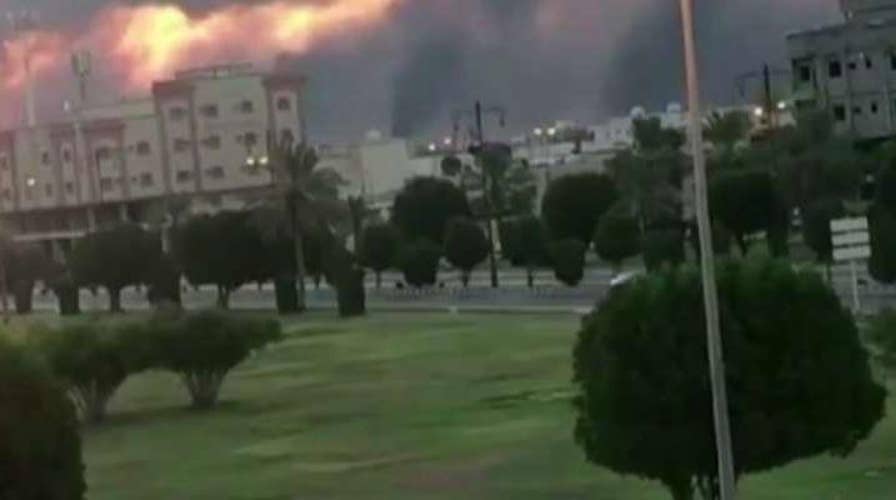Iran denies US claim that it was involved in drone attacks on Saudi oil facilities
Hudson Institute senior fellow Michael Pregent says he believes without a doubt that Iran was involved in the attacks on Saudi oil facilities.
Only the Iranians, the world’s worst diplomats, would mastermind a significant attack on Saudi Arabia’s oil facilities just days before the United Nations General Assembly opens.
Yet that’s what all signs point too. Secretary of State Mike Pompeo tweeted after the Saturday attack that “Iran has now launched an unprecedented attack on the energy supply. There is no evidence the attacks came from Yemen.”
Iran has the technology to mount such an attack. It has gotten help from Russia and China over the years. And we’ve seen Iran do things like this before.
BEHNAM BEN TALEBLU: ATTACK ON SAUDI OIL FACILITY SHOWS TRUMP WAS RIGHT TO PULL OUT OF IRAN NUKE DEAL
The attack Saturday on the Saudi oil facilities was the second recent strike against the Saudi Aramco oil company. On Aug. 17, 20 drones hit the Shaybah liquid natural gas facility in Saudi Arabia, causing a small fire.
More from Opinion
On Aug. 25, Israel launched a preemptive strike against an Iranian drone base in Syria.
Back in 2017, American F-15 pilots shot down Iranian drones over Syria when the drones tried to bomb U.S. forces working with allies on the ground.
Whatever Iran is up to, the Saudi Aramco strike was a significant escalation. Seventeen points of impact were precisely targeted, U.S. officials said. This surveillance and planning required for this strike were evidence of a whole new level of sophistication.
Oil storage facilities are soft targets. Hit them, spill some fuel, and the result is a really big fire.
Saudi Aramco has been in the oil business for a long time, so pre-surveying the site for target coordinates would not be hard. Still, the accuracy of the strikes suggests advanced help. Russia and China could easily have provided know-how at some point. Or Iran may have used unmanned drones to determine the coordinates.
The Saudi Aramco strike shows Iran can hit other targets throughout the region – directly or by proxy. The Dubai airport, the new nuclear plant under construction in the United Arab Emirates and other Saudi oil infrastructure are all vulnerable to Iran’s drones and cruise missiles.
Right now, the Trump administration is playing it cool. Pompeo and other senior officials are pointing at Iran as being behind the Saturday attack but are keeping American options open. Step 1, of course, is security for our military forces in the region.
U.S. military leaders will certainly review options to strike Iran. That’s their job. Commanders at Central Command must prepare options available to President Trump.
Strikes on a drone base would be one option. So would a limited attack on Iranian oil facilities, like the 1988 strikes by the U.S. Navy on Iranian offshore oil rigs and naval vessels.
Any strike options would be limited and proportional. Most of all, an attack would be carried out only in consultation with Saudi Arabia and other allies – especially Britain, Australia and Bahrain. Those nations are part of Operation Sentinel, the maritime stability force protecting Persian Gulf shipping.
Could the drones and missiles have come from Yemen? Maybe. Iran has been supporting the Houthi rebels in Yemen’s civil war, while a Saudi-led coalition is assisting the government of Yemen.
However, Pompeo’s statement that the attacks did not come from Yemen must be taken seriously. In this case, the U.S., Saudi Arabia and other allies have plenty of “eyes in the skies” watching everything that moves over the Persian Gulf region.
U.S. military leaders will certainly review options to strike Iran. That’s their job.
For example, drones and/or cruise missiles inbound from Iran’s coast to Saudi Aramco’s Abqaiq oil facility in the Eastern Province of Saudi Arabia could have been seen by military forces.
The Iranian cruise missile specter has worried military planners for quite some time. Novator, the Russian company that made the 9M729 missile that led to the end of the Intermediate-Range Nuclear Forces Treaty, began marketing the Club-K “cruise missile in a box” several years ago.
This devastating system could hide inside a standard shipping container, giving customers a “long-range precision strike capability to ordinary vehicles that can be moved to almost any place on earth without attracting attention,” venerable Jane’s Defense Weekly reported in 2010.
The point is that Russia, China and others have sold Iran advanced missile technology. And they have been egging Iran on as President Hassan Rouhani plays at nuclear blackmail and refuses to talk.
President Trump need not rush to action. He’s proven to be methodical and cautious with the use of military force. He prefers talks to strikes. A lot hinges on what the Kingdom of Saudi Arabia chooses to do.
CLICK HERE TO SIGN UP FOR OUR OPINION NEWSLETTER
Here in the U.S., the Strategic Petroleum Reserve gives us ample time for Saudi Aramco to repair damage and restore output. The reserve of over 700 million barrels is stored in salt caves in Texas and Louisiana. It was tapped during Hurricane Katrina in 2005, and Trump on Sunday authorized the release of oil from the reserve to keep oil markets stable.
To my mind, the pressure is now on the United Nations. The U.N. General Assembly, which opens in New York on Tuesday, needs to address Iran’s behavior.
The U.N., after all, is the big honcho behind the Iran nuclear deal. The U.N. also runs the International Atomic Energy Agency, which has confirmed Iran’s nuclear violations.
CLICK HERE TO GET THE FOX NEWS APP
The world body shouldn’t focus only on climate change and sustainable development and shirk its core mission of conflict resolution. It will lose a lot of credibility if it can’t deal more effectively with Iran.
One thing is for certain: Iran must never acquire a nuclear weapon.





















